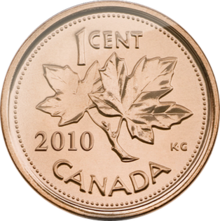Cent (Canadian coin)
| Canada | |
| Value | 0.01 CAD |
|---|---|
| Mass | 2.35 g |
| Diameter | 19.05 mm |
| Thickness | 1.45 mm |
| Edge | smooth |
| Composition | 94% steel, 1.5% Ni, 4.5% Cu plating |
| Years of minting | 1858–2012 |
| Catalog number | CC 20 |
| Obverse | |
 |
|
| Design | Elizabeth II, Queen of Canada |
| Designer | Susanna Blunt |
| Design date | 2003 |
| Reverse | |
 |
|
| Design | Maple leaf branch |
| Designer | G.E. Kruger Gray |
| Design date | 1937 |
In Canada, a penny is a coin worth one cent, or 1⁄100 of a dollar. According to the Royal Canadian Mint, the official national term of the coin is the "one-cent piece", but in practice the terms penny and cent predominate. Originally, "penny" referred to a two-cent coin. When the two-cent coin was discontinued, penny took over as the new one-cent coin's name. Penny was likely readily adopted because the previous coinage in Canada (up to 1858) was the British monetary system, where Canada used British pounds, shillings, and pence as coinage alongside U.S. decimal coins and Spanish milled dollars.
In Canadian French, the penny is called a cent, which is spelled the same way as the French word for "hundred" but pronounced like the English word (homonym to "sent"). Slang terms include cenne, cenne noire, or sou noir (black penny), although common Quebec French usage is sou.
Production of the penny ceased in May 2012, and the Royal Canadian Mint ceased the distribution of them as of February 4, 2013. However, like all discontinued currency in the Canadian monetary system, the coin remains legal tender. Once distribution of the coin ceased, though, vendors were no longer expected to return pennies as change for cash purchases, and were encouraged to round purchases to the nearest five cents. Non-cash transactions are still denominated to the cent.
Like all Canadian coins, the obverse depicts the reigning Canadian monarch at the time of issue. The final obverse depicts Queen Elizabeth II; her likeness has seen three design updates, the first occurring in 1965, a 1990 update to the design of Dora de Pedery-Hunt, and the 2003 update designed by Susanna Blunt. A special reverse side, depicting a rock dove, was issued in 1967 as part of a Centennial commemoration. It was designed by the Canadian artist Alex Colville and its use in 1967 marked the only time the 1937 maple leaf design was not used for the penny before it was discontinued in 2012. The maple twig depicted on the coin is botanically incorrect. The Phyllotaxis of the twig on the coin is clearly alternate while maples in fact always have opposite leaves.
...
Wikipedia
